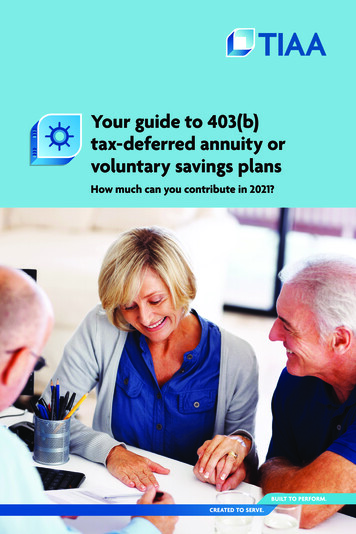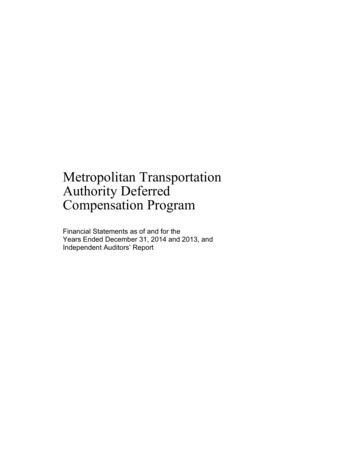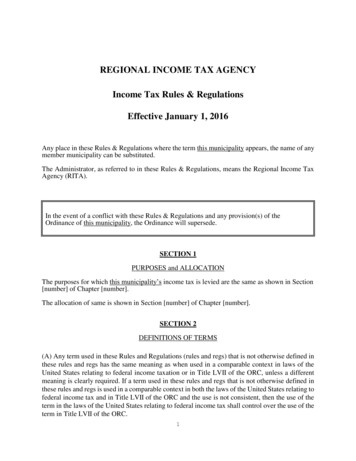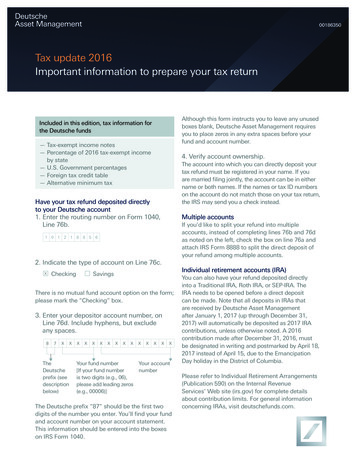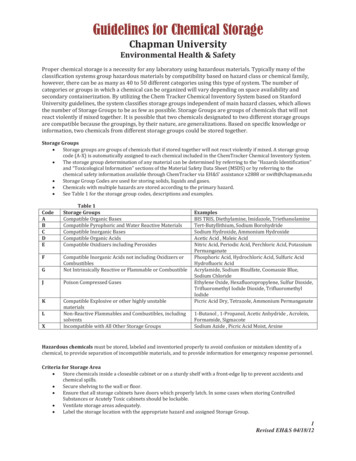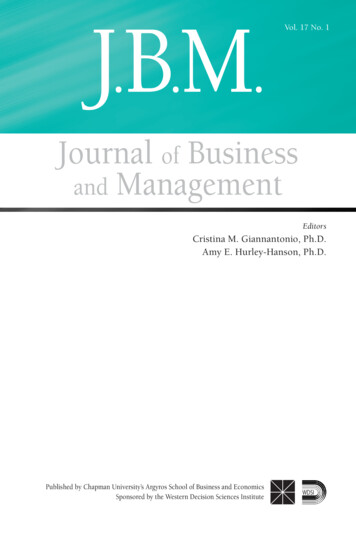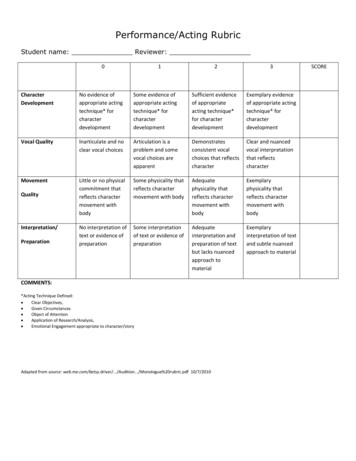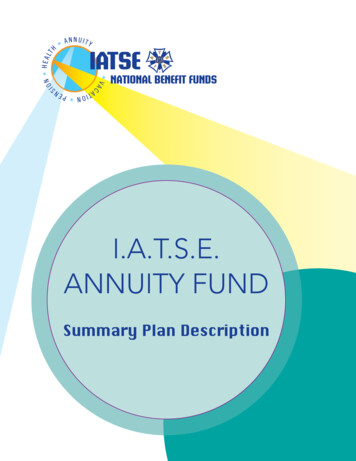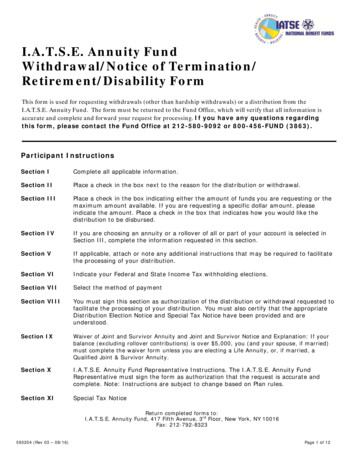
Transcription
CHAPMAN UNIVERSITY TAX-DEFERRED ANNUITY (TDA) RETIREMENT PLANSUMMARY PLAN DESCRIPTION150556 150558
TABLE OF CONTENTSINTRODUCTION TO YOUR PLANARTICLE IPARTICIPATION IN THE PLANHow do I participate in the Plan? . 1What happens if I'm a Participant, terminate employment and then I'm rehired? . 2ARTICLE IIEMPLOYEE CONTRIBUTIONSWhat are elective deferrals and how do I contribute them to the Plan? . 2What are rollover contributions? . 2ARTICLE IIICOMPENSATION AND ACCOUNT BALANCEWhat compensation is used to determine my Plan benefits? . 3Is there a limit on the amount of compensation which can be considered? . 3Is there a limit on how much can be contributed to my account each year? . 3How is the money in the Plan invested? . 4Will Plan expenses be deducted from my account balance? . 4ARTICLE IVVESTINGWhat is my vested interest in my account? . 4ARTICLE VDISTRIBUTIONS PRIOR TO TERMINATION OF EMPLOYMENTCan I withdraw money from my account while working? . 5Can I withdraw money from my account in the event of financial hardship? . 5ARTICLE VIDISTRIBUTIONS UPON TERMINATION OF EMPLOYMENTWhen can I get money out of the Plan? . 6What is Normal Retirement Age and what is the significance of reaching Normal Retirement Age? . 6When am I considered to be disabled under the Plan?. 6How will my benefits be paid to me?. 7May I elect another distribution method? . 7ARTICLE VIIDISTRIBUTIONS UPON DEATHWhat happens if I die while working for the Employer? . 7Who is the beneficiary of my death benefit? . 7How will the death benefit be paid to my beneficiary? . 8When must payments be made to my beneficiary (required minimum distributions)? . 8What happens if I terminate employment, commence required minimum distribution payments and then die beforereceiving all of my benefits? . 8i
ARTICLE VIIITAX TREATMENT OF DISTRIBUTIONSWhat are my tax consequences when I receive a distribution from the Plan?. 8Can I elect a rollover to reduce or defer tax on my distribution? . 9ARTICLE IXLOANSIs it possible to borrow money from the Plan? . 9ARTICLE XPROTECTED BENEFITS AND CLAIMS PROCEDURESAre my benefits protected? . 9Are there any exceptions to the general rule? . 10Can the Employer amend the Plan? . 10What happens if the Plan is discontinued or terminated? . 10How do I submit a claim for Plan benefits? . 10What if my benefits are denied? . 10What is the claims review procedure? . 11What are my rights as a Plan Participant? . 13What can I do if I have questions or my rights are violated? . 13ARTICLE XIGENERAL INFORMATION ABOUT THE PLANPlan Name. 14Plan Number . 14Plan Effective Dates . 14Other Plan Information . 14Employer Information . 14Plan Administrator Information . 14ii
CHAPMAN UNIVERSITY TAX-DEFERRED ANNUITY (TDA) RETIREMENT PLANSUMMARY PLAN DESCRIPTIONINTRODUCTION TO YOUR PLANChapman University Tax-Deferred Annuity (TDA) Retirement Plan ("Plan") has been adopted to provide you with the opportunity tosave for retirement on a tax advantaged basis. This Plan is a type of retirement plan known as a 403(b) plan. This Summary PlanDescription ("SPD") contains information regarding when you may become eligible to participate in the Plan, your Plan benefits, yourdistribution options, and many other features of the Plan. You should take the time to read this SPD to understand the features of thePlan.This SPD addresses the most common questions you might have regarding the Plan. If this SPD does not answer all of yourquestions, please contact the Plan Administrator or other Plan representative. The Plan Administrator is generally responsible forresponding to questions and making determinations related to the administration, interpretation, and application of the Plan, unlessthose responsibilities have been delegated to other parties. The name of the Plan Administrator can be found at the end of this SPD inthe Article entitled "General Information about the Plan."This SPD describes the Plan's benefits and obligations as contained in the legal Plan document, which governs the operation of thePlan. The Plan document is written in much more technical and precise language and is designed to comply with applicable legalrequirements. If the non-technical language in this SPD and the technical, legal language of the Plan document conflict, the Plandocument always governs. If you wish to receive a copy of the legal Plan document, please contact the Plan Administrator.This SPD describes the current provisions of the Plan. The Plan is subject to federal laws, such as ERISA (the Employee RetirementIncome Security Act), the Internal Revenue Code and other federal and state laws which might affect your rights. The provisions ofthe Plan are subject to revision due to a change in laws or due to pronouncements by the Internal Revenue Service (IRS) orDepartment of Labor. Your Employer may also amend or terminate this Plan. The Plan Administrator will notify you if the provisions ofthe Plan that are described in this SPD change.Investment arrangement. The investment products you select (known as investment arrangements) may also affect the provisions ofthe Plan. In some cases the investment arrangements may limit your options under the Plan. This SPD does not address theprovisions of the various investment arrangements. You should contact the Plan Administrator or the investment provider if you havequestions about the provisions of your specific investment arrangements.Types of contributions. The following types of contributions are allowed under this Plan: Employee elective deferrals including Roth Deferrals Employee rollover contributionsARTICLE IPARTICIPATION IN THE PLANHow do I participate in the Plan?Provided you are not an Excluded Employee, you can begin participating under the Plan once you have satisfied the eligibilityrequirements and reached your Entry Date, except as indicated below for reclassified employees. The following describes ExcludedEmployees, the eligibility requirements and Entry Dates that apply. You should contact the Plan Administrator if you have questionsabout the timing of your Plan participation.Elective DeferralsExcluded Employees. If you are a member of a class of employees identified below, you are an Excluded Employee and youare not entitled to participate in the Plan for purposes of elective deferrals. The employees who are excluded are: certain nonresident aliens who have no earned income from sources within the United States employees who are enrolled as students and regularly attending classes offered by the EmployerSee "Additional Excluded Employee provisions" below for special provisions that might apply in determining who is an ExcludableEmployee.Eligibility Conditions. You will be eligible to participate in elective deferrals on your date of hire. However, you will actuallyparticipate in elective deferrals once you reach the Entry Date as described below.Entry Date. For purposes of elective deferrals, your Entry Date will be your date of hire.Additional Excluded Employee provisionsEmployees of Brandman University are excluded for all contributions. See the Plan Administrator for additional information if you arenot sure if this affects you.1
Reclassified EmployeeRegardless of the above, if it is determined that your Employer erroneously classified you as a non-Employee and you should havebeen treated as an Employee, you are not entitled to participate in the Plan.What happens if I'm a Participant, terminate employment and then I'm rehired?If you are no longer a Participant because of a termination of employment, and you are rehired, then you will be able to participate inthe Plan on the date on which you are rehired if you are otherwise eligible to participate in the Plan.ARTICLE IIEMPLOYEE CONTRIBUTIONSWhat are elective deferrals and how do I contribute them to the Plan?Elective Deferrals. As a Participant under the Plan, you may elect to reduce your compensation by a specific percentage and havethat amount contributed to the Plan as an elective deferral. There are two types of elective deferrals: Pre-Tax Deferrals and RothDeferrals. For purposes of this SPD, "elective deferrals" generally means both Pre-Tax Deferrals and Roth Deferrals. Regardless ofthe type of elective deferral you make, the amount you defer is counted as compensation for purposes of Social Security taxes.Pre-Tax Deferrals. If you elect to make Pre-Tax Deferrals, then your taxable income is reduced by the deferral contributions soyou pay less in federal income taxes. Later, when the Plan distributes the deferrals and earnings, you will pay the taxes on thosedeferrals and the earnings. Therefore, with a Pre-Tax Deferral, federal income taxes on the elective deferral contributions and onthe earnings are only postponed. Eventually, you will have to pay taxes on these amounts.Roth Deferrals. If you elect to make Roth Deferrals, the elective deferrals are subject to federal income taxes in the year ofelective deferral. However, the elective deferrals and, in certain cases, the earnings on the elective deferrals are not subject tofederal income taxes when distributed to you. In order for the earnings to be tax free, you must meet certain conditions. See"What are my tax consequences when I receive a distribution from the Plan?" below.You will always be 100% vested in your elective deferrals (see the Article in this SPD entitled "Vesting").Elective Deferral procedure. The amount you elect to defer will be deducted from your pay in accordance with a procedureestablished by the Plan Administrator. If you wish to defer, the procedure will require that you enter into a Salary ReductionAgreement. You may elect to defer a portion of your compensation payable on or after your Entry Date. Such election will becomeeffective as soon as administratively feasible after it is received by the Plan Administrator. Your election will generally remain in effectuntil you modify or terminate it.Elective Deferral modifications. You may revoke or make modifications to your salary deferral election in accordance withprocedures that the Employer provides. See the Plan Administrator for further information.Elective Deferral Limit. As a Participant, you may elect to defer a percentage of your compensation each year instead of receivingthat amount in cash. Your total elective deferrals in any taxable year cannot exceed a dollar limit which is set by law. The limit for2020 is 19,500. After 2020, the dollar limit may increase for cost-of-living adjustments. See the paragraph below on Annual dollarlimit.Age 50 Catch-Up Deferrals. If you are at least age 50 or will attain age 50 before the end of a calendar year, then you may elect todefer additional amounts (called Age 50 Catch-Up Deferrals) to the Plan as of the January 1st of that year. You can defer theadditional amounts regardless of any other limitations on the amount you can defer to the Plan. The maximum Age 50 Catch-UpDeferrals that you can make in 2020 is 6,500. After 2020, the maximum might increase for cost-of-living adjustments.Annual dollar limit. You should also be aware that each separately stated annual dollar limit on the amount you may defer (theannual deferral limit and the "catch-up contribution" limit) is a separate aggregate limit that applies to all such similar salary deferralamounts and "catch-up contributions" you may make under this Plan and any other cash or deferred arrangements (including othertax-sheltered 403(b) annuity contracts, simplified employee pensions or 401(k) plans) in which you may be participating. Generally, ifan annual dollar limit is exceeded, then the excess must be returned to you in order to avoid adverse tax consequences. For thisreason, it is desirable to request in writing that any such excess salary deferral amounts and "catch-up contributions" be returned toyou.If you are in more than one plan, you must decide which plan or arrangement you would like to return the excess. If you decide thatthe excess should be distributed from this Plan, you must communicate this in writing to the Plan Administrator no later than theMarch 1st following the close of the calendar year in which such excess deferrals were made. However, if the entire dollar limit isexceeded in this Plan or any other plan the Employer maintains, then you will be deemed to have notified the Plan Administrator ofthe excess. The Plan Administrator will then return the excess deferral and any earnings to you by April 15th.What are rollover contributions?Rollover contributions. Subject to the provisions of your investment arrangements and at the discretion of the Plan Administrator, ifyou are a Participant in the Plan, you might be permitted to deposit into the Plan distributions you have received from other plans andcertain IRAs. Such a deposit is called a "rollover" contribution and might result in tax savings to you. You may ask the Plan2
Administrator of the other plan or the trustee or custodian of the IRA to directly transfer (a "direct rollover") to this Plan all or a portionof any amount that you are entitled to receive as a distribution from such plan. Alternatively, you may elect to deposit any amounteligible to be rolled over within 60 days of your receipt of the distribution. You should consult qualified counsel to determine if arollover is in your best interest.Rollover account. Your rollover contribution will be accounted for in a "rollover account." You will always be 100% vested in your"rollover account" (see the Article in this SPD entitled "Vesting"). Rollover contributions will be affected by any investment gains orlosses. In addition, any Roth deferrals that are accepted as rollovers in this Plan will be accounted for separately.Withdrawal of rollover contributions. You may withdraw the amounts in your "rollover account" at any time.ARTICLE IIICOMPENSATION AND ACCOUNT BALANCEWhat compensation is used to determine my Plan benefits?All ContributionsDefinition of compensation. Compensation is defined as "Compensation" for faculty means the salary stated in the academic yearcontract paid during the Plan Year. "Compensation" for all other categories of Employees means the basic annual compensation paideach Plan Year including basic salaries and wages before any salary reduction agreement made pursuant to Sections 125 and 403(b)of the Code for the Plan Year.Adjustments to compensation. Regardless of the definition of compensation, the following adjustments will be made: elective deferrals to this Plan and to any other plan or arrangement (such as a cafeteria plan) will be included. compensation paid while not a Participant in the component of the Plan for which compensation is being used will beexcluded. bonuses will be excluded. commissions will be excluded. overtime will be excluded. stipends, allowances an
CHAPMAN UNIVERSITY TAX-DEFERRED ANNUITY (TDA) RETIREMENT PLAN SUMMARY PLAN DESCRIPTION INTRODUCTION TO YOUR PLAN Chapman University Tax-Deferred Annuity (TDA) Retirement Plan ("Plan") has been adopted to provide you with the opportunity to save for retirement on a tax advantaged basis. This
